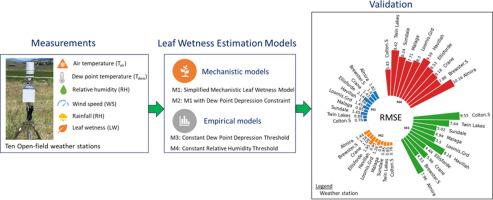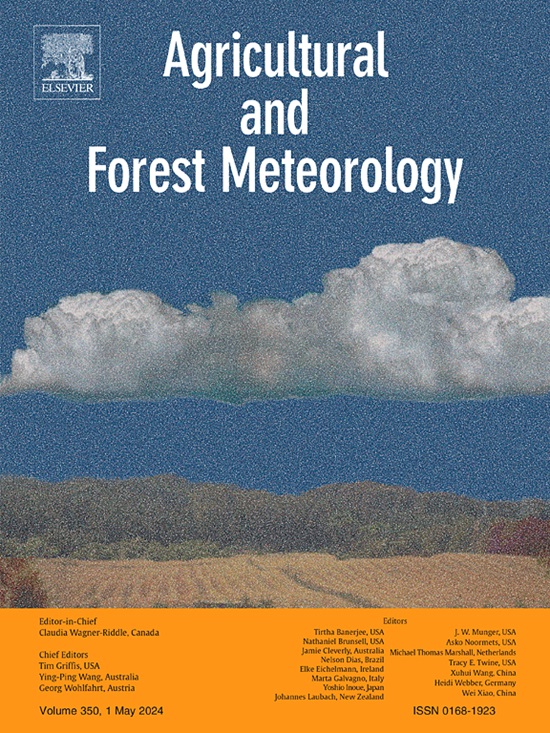Simplified mechanistic model for estimating leaf wetness
IF 5.6
1区 农林科学
Q1 AGRONOMY
引用次数: 0
Abstract
This study aimed to develop a simplified mechanistic leaf wetness estimation model (SMLW) to support risk assessment of insect pests and diseases in irrigated specialty crops grown in the state of Washington, and around globe. Employing the energy balance and water budget approach, two variants of SMLW models (M1: SMLW and M2: SMLWDPD) were developed using historical data from ten randomly selected automated weather stations in the Washington State University — AgWeatherNet ecosystem. Both variants simulate dewfall, rainfall interception, and evaporation processes; however, SMLWDPD incorporates dew point depression (DPD) as an additional constraint. Both models enabled estimation of leaf wetness (LW, mm) and leaf wetness duration (LWD, h, defined as the duration when LW > 0). The model input parameters were optimized through the Bayesian method and Morris's sensitivity index. For comparison, LWD was also estimated following existing empirical approaches based on constant DPD (M3) and relative humidity (M4). The LWD estimates from all four models were finally evaluated against actual historical leaf wetness sensor data. Results indicated that SMLW and SMLWDPD outperform M3 and M4 in estimating daily LWD. With relatively higher precision and recall, SMLWDPD exhibited higher coefficient of determination (0.84) with root mean squared (RMSE) and absolute error (MAE) of 1.13 h and 0.34 h, respectively. Whereas, both M3 and M4 had MAE of 10.16 h and 7.03 h, respectively. Overall, SMLWDPD model could be a viable option to reliably estimate leaf wetness using typical weather variables and reducing reliance on intricate inputs such as net radiation and leaf area index. Tied with other weather variables like degree days, LWD estimated using SMLWDPD can be an effective decision support for growers in determining optimal timing and frequency of sprays to manage insect pests and disease pressure.


叶片湿度估算的简化机制模型
本研究旨在建立一个简化的叶片湿度估算模型(SMLW),以支持华盛顿州和全球灌溉特种作物病虫害风险评估。采用能量平衡和水收支方法,利用华盛顿州立大学- AgWeatherNet生态系统中随机选择的10个自动化气象站的历史数据,开发了两种SMLW模型(M1: SMLW和M2: SMLWDPD)。这两个变量模拟露珠、降雨拦截和蒸发过程;然而,SMLWDPD将露点降低(DPD)作为附加约束。两个模型都可以估算叶片湿度(LW, mm)和叶片湿度持续时间(LWD, h),定义为LW >;0).通过贝叶斯方法和莫里斯灵敏度指数对模型输入参数进行优化。为了进行比较,还根据现有的基于恒定DPD (M3)和相对湿度(M4)的经验方法估计了LWD。最后,根据叶片湿度传感器的实际历史数据,对所有四种模型的LWD估计值进行了评估。结果表明,SMLW和SMLWDPD在估计每日随钻深度方面优于M3和M4。SMLWDPD具有较高的精密度和召回率,具有较高的决定系数(0.84),均方根(RMSE)和绝对误差(MAE)分别为1.13 h和0.34 h。M3和M4的MAE分别为10.16 h和7.03 h。综上所述,SMLWDPD模型可以利用典型天气变量可靠地估算叶片湿度,减少对净辐射和叶面积指数等复杂输入的依赖。与其他天气变量(如摄氏度)相结合,使用SMLWDPD估计的LWD可以为种植者提供有效的决策支持,以确定喷洒的最佳时间和频率,以管理虫害和疾病压力。
本文章由计算机程序翻译,如有差异,请以英文原文为准。
求助全文
约1分钟内获得全文
求助全文
来源期刊
CiteScore
10.30
自引率
9.70%
发文量
415
审稿时长
69 days
期刊介绍:
Agricultural and Forest Meteorology is an international journal for the publication of original articles and reviews on the inter-relationship between meteorology, agriculture, forestry, and natural ecosystems. Emphasis is on basic and applied scientific research relevant to practical problems in the field of plant and soil sciences, ecology and biogeochemistry as affected by weather as well as climate variability and change. Theoretical models should be tested against experimental data. Articles must appeal to an international audience. Special issues devoted to single topics are also published.
Typical topics include canopy micrometeorology (e.g. canopy radiation transfer, turbulence near the ground, evapotranspiration, energy balance, fluxes of trace gases), micrometeorological instrumentation (e.g., sensors for trace gases, flux measurement instruments, radiation measurement techniques), aerobiology (e.g. the dispersion of pollen, spores, insects and pesticides), biometeorology (e.g. the effect of weather and climate on plant distribution, crop yield, water-use efficiency, and plant phenology), forest-fire/weather interactions, and feedbacks from vegetation to weather and the climate system.

 求助内容:
求助内容: 应助结果提醒方式:
应助结果提醒方式:


